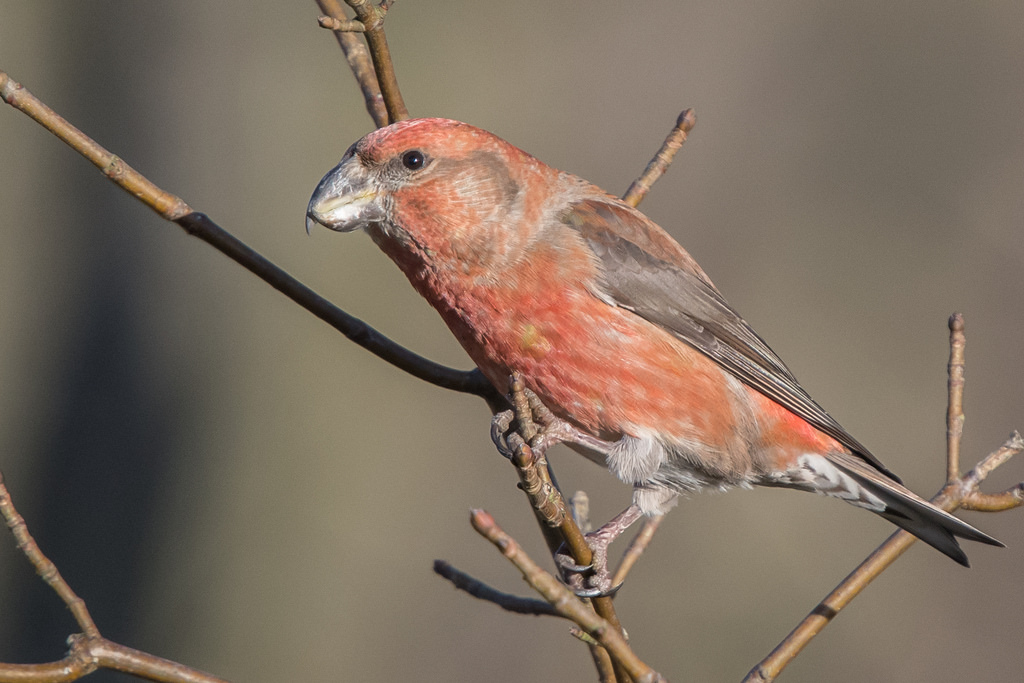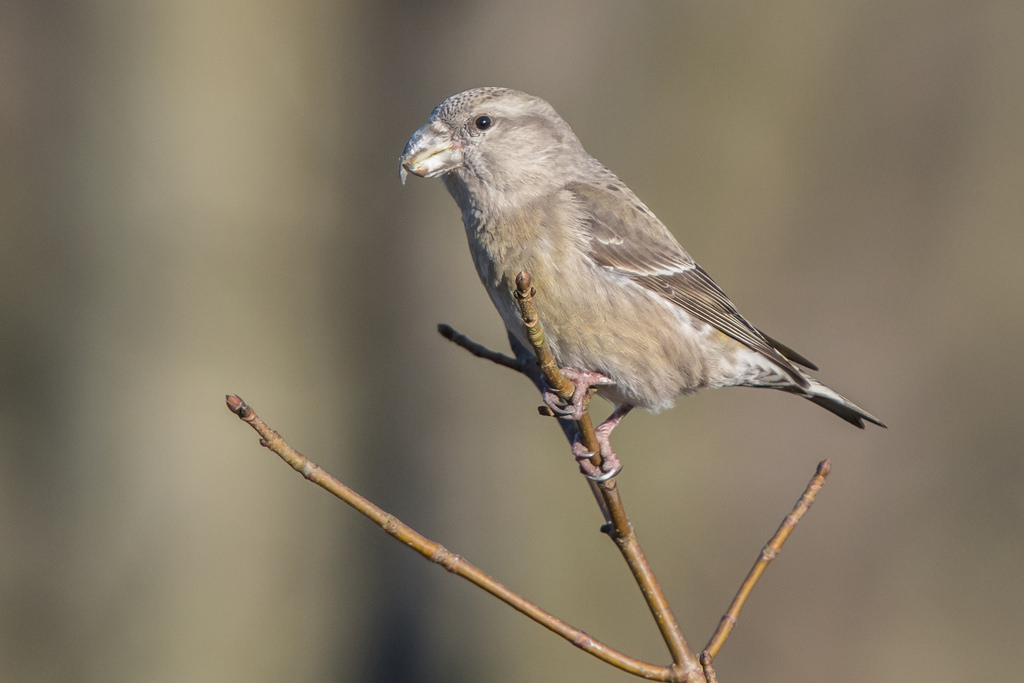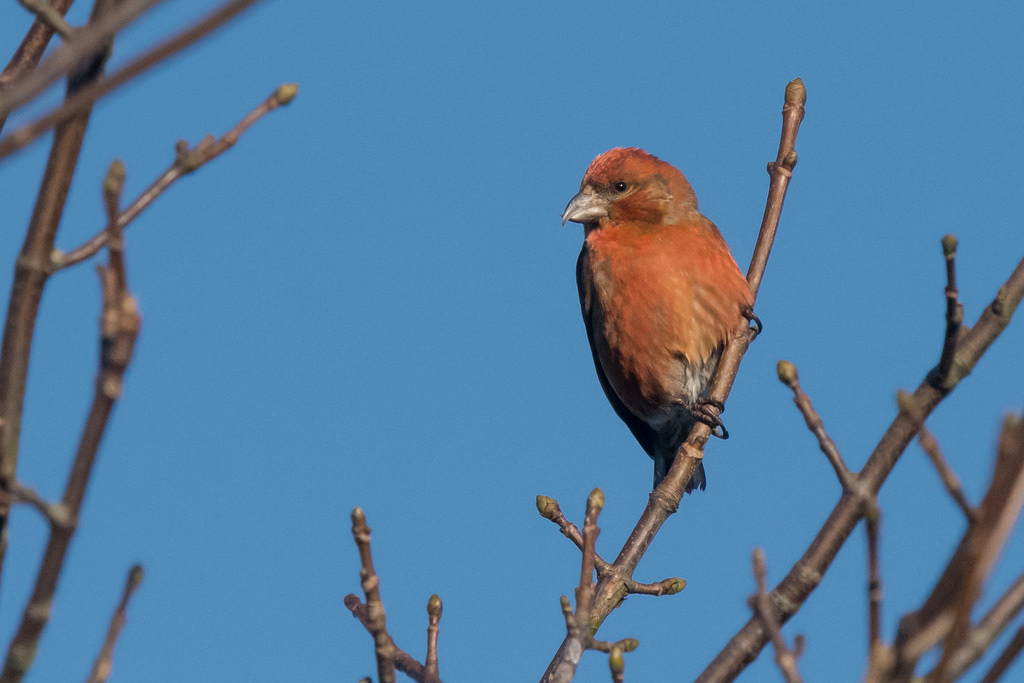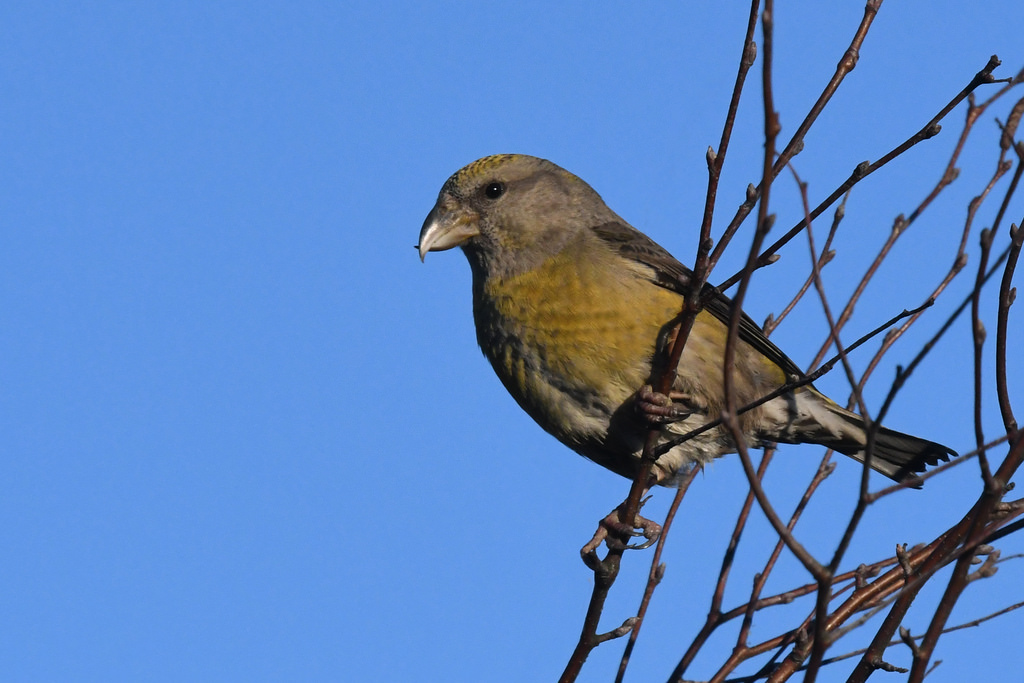
Parrot Crossbills are restricted to the Western Palearctic, breeding mainly in Scandinavia and NW Russia. But this population is nomadic, occasionally wandering to Britain when their pine cone crop fails. Wandering birds occasionally stay here to breed, and it has become apparent in recent years that a population of about 100 pairs breeds in Caledonian pine forests in Strathspey and Deesside. 2017 has seen an invasion of Parrot Crossbills into Britain, including a flock of at least 12 birds In the Upper Derwent Valley in the Peak District, which is where I photographed these.

Identification is not especially easy, and incidentally DNA cannot separate Common, Scottish or Parrot Crossbills. Parrots are a bit larger with a heavier neck, and a larger bill. The lower mandible swells towards the tip unlike the even curve of Common Crossbill. Also the upper mandible is so large that the point of the lower mandible does not usually protrude, again unlike Common Crossbill. But there was variation in bill size among the 12 birds present, and not all had absolutely massive bills. Because I listen to Common Crossbills all the time their calls sounded very different to me; a lower pitched, but very loud “choop”, compared with the higher “chip” of Crossbill.
The scientific name Loxia pytyopsittacus is interesting too. Loxia means slanted or crosswise, referring to the bill, and pytyopsittacus translates as parrot of the pines from the Greek Pitus (pine tree) and psittakos (parrot).


[registration_form]
Thanks Tim for the nice pics and words.
Love the same-DNA-some-difference thing.
Perhaps this is ‘speciation by creeps’ mediated by chips and chooks. Your observations of their calls might be about evolution in the soundscape or, at least, about an enviable something…
Do they interbreed in Scotland?
Thanks Murray. Apparently each species in Scotland only mates with birds of its own bill size and vocalisations. Bill size is heritable so matings between different bill types might produce intermediate bill types that are not suited to the various conifer options. Parrots usually specialise on Scots Pine, Commons on Larch and Spruce, with Scottish Crossbills having a more mixed diet.
I do wonder whether the vocalisations simply reflect the fact that bigger bills, feeding on bigger cones need bigger neck muscles, which in turn gives a deeper call. But detailed work on Common Crossbills have revealed sub-populations with apparently diagnostic vocal differences (remember hearing about Phantom, Wandering and Bohemian Crossbills etc?). These may be yet more species in the making.
Thanks for that and the interesting following discussion.
I’m a bit unsure as to which is which: your article says that Commons have the deeper call but your reply suggests the larger Parrots have the ‘choop’ rather than the ‘chip’. But, it might be that I’m one chip short of a portion when it comes to reading things.
Anyway, apart from simple mechanics – the larger the vessel, the deeper the sound – you made me think about the prevalence in nature of the ‘high pitch/low pitch’ rule. The lower frequency ‘choop’ could be an adaptation to dense forest (low pitch sounds penetrate thick vegetation better than high pitch signals which are in turn better at overcoming noise). The ‘application’ of this rule can be as subtle as the Firecrest having a slightly deeper song than the Goldcrest – closely related species where the former forages within the tree canopy while the latter tends to work the edge of it. Or, the rule can be very obvious, as in forest versus savannah elephants. They are of course same species but the former has a call one octave lower than its open park neighbour.
My favourite, comparison is that of the Wood Pigeon’s song versus that of the much deeper one of the Stock Dove. Really, their names should be swapped round.
The most theoretically elegant narrative would be that the archaic British (Scotland, perhaps also East Anglian Brecks?) species was Parrot; simply adapted to feed on the native Scots Pine as it is elsewhere in it’s range. Scottish Crossbill would then become a ‘man made’ species evolving from Parrot Crossbill following the deforestation of the ancient Caledonian woods and then the widespread replacement by non-native species (during the 18th & 19th Centuries) creating an environment where an ‘intermediate species’ could survive in a landscape of variable cone sizes. It would be interesting to get statistics on how unique (or otherwise) a woodland landscape Highland Scotland is (e.g. large scale deforestation followed by replacement by alien species) compared to any other parts of Europe (Fenno-Scandia, Western Russia, Mediterranean, Balkans etc.) where large-billed predominantly pine eating crossbills (whether Parrot or those currently classified a Common) occur.
PS. Murray; I think it’s just Tim’s turn of phrase – Parrot deeper, Common higher. Obviously perception of sound is individually variable. To me Parrot flight calls (particularly when in flocks) don’t sound like ‘choop’ very often, more usually it’s a ringing ‘peet’ or similar. Their excitement calls (‘toops’) were described memorably by Scottish crossbill researcher Lindsay Cargill as being a ”cluck’ reminiscent of a Blackbird alarm call, or more closely a Jackdaw (and between the two in ‘pitch’ and timbre)’ and that works really well for me. It’s not been updated for years but if readers want to look more closely into all things Loxia, Lindsay’s blog remains a key resource;
http://pinemuncher.blogspot.co.uk/
Direct link to Lindsay’s call descriptions here;
http://pinemuncher.blogspot.co.uk/2011/03/toop-toop-choop-choop.html
Jim, thanks a lot for the link.
Heady, techy stuff that flies mostly above my head. Here’s an extract from Lindsay Cargill’s blog in response to a Loxia fan in Newfoundland:
”Regarding the splitting of calls I mentioned to you last year that Fc1 seems to have many variants and that in reality (practicality !)there appear to be predominantly “Fc1” and “Fc4” Common types in the UK – this was following discussions I had with Ron Summers last year when we were ringing crossbills, and we both seemed to agree on this. Here in NE Scotland we currently have a ‘strain’ of Crossbills that irrupted here last Summer that sound like Fc4 (“glips”) but in actual fact are variants of “parakeet” 2B types eg. they are giving a Fc1. I caught a male in Jan who gave one type of this call on release, then was joined by his female and then sychronised his call to his mate, who gave the variant call.”
Is this train-spotting gone mad? No, this is an extraordinary effort in dissecting and archiving the minutiae of bird communication for posterity. Unfortunately, his blog seems to have stopped in 2014.
Hi Murray. Yeah, maybe I should have mentioned Lindsay has something of a particular writing style! However, there really is some quality information in there, along with commendably flexible theoretical musings, that are right at the cutting edge of research. I really wish he would collate his data at some point (in a reasonably accessible form) but I don’t know him personally (I just followed his blog when it was active, and had some brief correspondence with him about Parrot Crossbills over the winter 2013/14) so no idea what he is up to now.
Presumably the DNA must be different but just not in the bits that have been looked at so far. The larger bills must, surely, have a genetic basis?
I agree Ian, and bill size is definitely heritable, but DNA sequencing used to diagnose different taxa does not reveal significant differences. Quoting Knox & Parkin (Status of Birds in Britain and Ireland, 2010) “Recent molecular analysis has shown that curvirostra is closely related to scotica and pytyopsittacus and that DNA sequences cannot separate this trio.”
Lovely pictures as usual Tim. I’ve heard and seen Parrot Crossbills on several occasions in the UK and northern Sweden. they certainly sound and look different if you are reasonably familiar with common. Indeed when caught for ringing they are considerably bigger in the hand with much larger bills, indeed Two Barred is the smallest of the trio in bill and overall dimensions.
One thing that has always intrigued me is that these three are irruptive moving long distances in search of food when crops local to them fail, this is responsible for the occasional appearance of Parrot and Two Barred in the UK, yet we are told and evidence seems to support that Scottish is a local resident.Before the advent of widespread forestry plantings it must have been reliant on Scots pine only and this has regional failure years in cone production, why is it not too an irruptive?
Thanks Paul. There have been no confirmed records of Scottish Crossbill outside Scotland but since people noticed Scottish Crossbills were different in the 1970s, there would have been other planted conifers available, to save them from having to irrupt. Given the highlands were uninhabitable during the last glaciation, which only ended 10,000 years ago, Scottish Crossbill must have recent origins (supported by lack of DNA differences). For much of this time Scots Pine would have been the only conifer available to all species in Britain (being the only native true conifer, as Yew and Juniper have berries, not cones), so presumably Scots Pine is what they fed on. I think Common Crossbill colonised Britain later when planted conifers became widespread. The fossil (Pleistocene) records of Crossbill in Britain did not distinguish between Scottish and Common. An early Crossbill irruption in 1251 (Matthew Paris in St Albans) refers to them eating the pips of crab apples when presumably there were no conifers for them. It was recorded breeding in England after irruptions since 1815, which is after planted conifers were available. A big invasion in 1910 saw them breeding in shelter belts in East Anglia and in the New Forest and Dorset.
Hi Tim are you saying that Scottish Crossbills may have been irruptive but no longer are? That would make some sense, I wonder and assume the same is true of the Crossbills on Corsica and Sardinia.
I suppose we will never know as they weren’t recognised as being different until recent decades. But as all other Crossbills irrupt when food runs out, I think that Scottish Crossbills would be likely to do the same. Also those on Mediterranean Islands though I would have thought that they would have native fall-back conifers if their favourite crop fails.